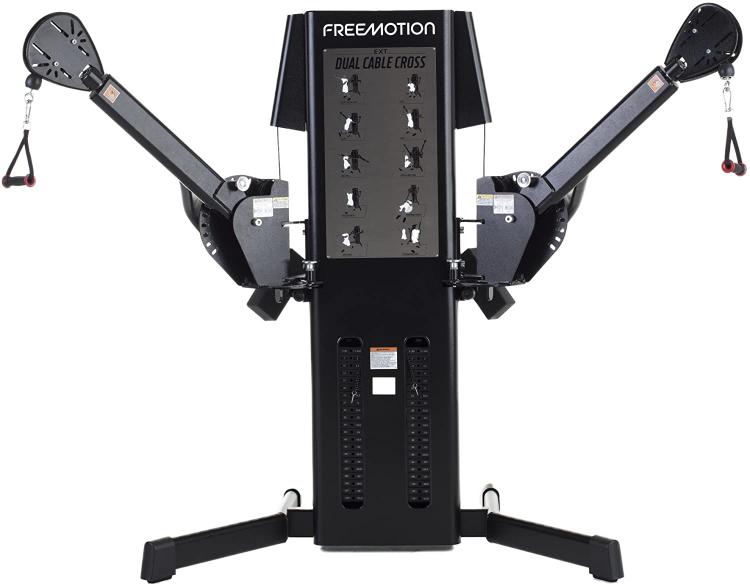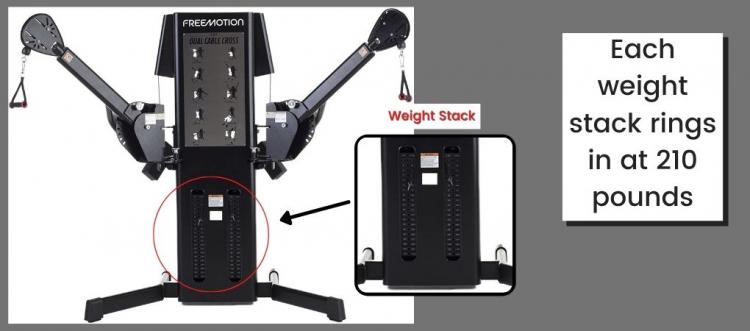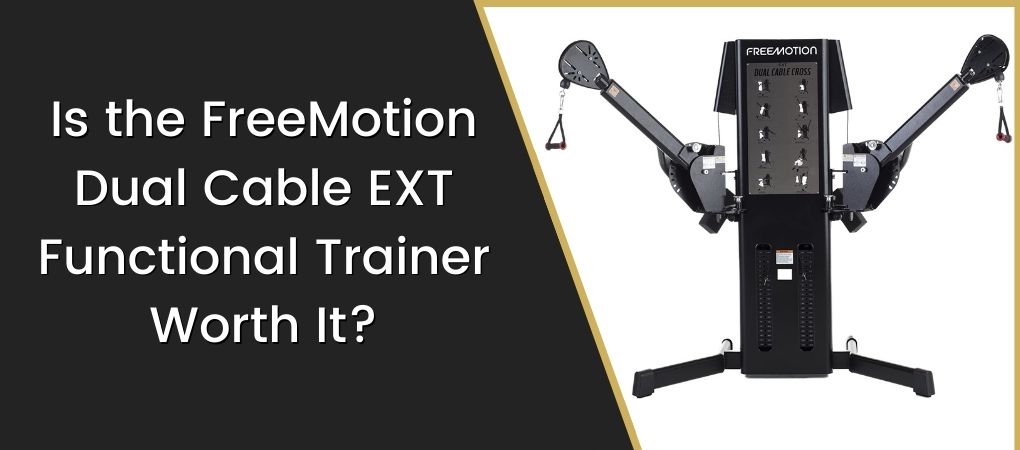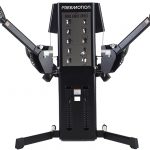FreeMotion re-imagines the basic functional trainer with a notable design change that breaks away from your standard box- or triangle-shaped machine. Instead, you get a single tower with two independently rotating arms.
FreeMotion promises that this unusual design gives the Dual Cable EXT functional trainer a competitive advantage. The company argues that these independent, mobile arms create a superior workout experience that better mimics your natural range of motion. And it’s true: The FreeMotion Dual Cable EXT functional trainer offers the widest range of motion among most popular functional trainers, and is excellent for both strength training and cardio.
The FreeMotion Dual Cable EXT functional trainer offers the widest range of motion among most popular functional trainers, and is excellent for both strength training and cardio. In this review, we explore whether it is worth its money, given its high price tag.
Find out more in our in-depth analysis of FreeMotion’s Dual Cable EXT functional trainer below. We’ll break down everything you need to know before buying this functional trainer, including:
● A quick snapshot: The pros and cons of the FreeMotion Dual Cable EXT functional trainer (and who it’s best for)
● Technical specifications, measurements, and weight
● Weight stacks and weight ratio (and why it matters)
● Included attachments and options
● Frame construction, durability, and assembly
● Exercise options that work with the FreeMotion Dual Cable EXT functional trainer
● What we love
● What to watch out for
● Our final thoughts: Is the FreeMotion Dual Cable EXT functional trainer worth its price tag?
In a Snapshot: The Pros and Cons of the FreeMotion Dual Cable EXT functional trainer

Nearly all other functional trainers, including popular competitors like the Inspire Fitness FT2 and the BodyCraft HFT, have the same basic design: A big, metal frame holding two weight stacks, with pulleys attached to the frame. In most cases, you can slide the pulley position up or down in order to adjust the angle and height of a specific exercise.
FreeMotion takes a completely different approach. Instead of the pulleys being attached to a static frame, the FreeMotion Dual Cable EXT instead has two swinging, mobile arms. Each arm has 12 different height settings, and nine horizontal settings.
Using mobile arms instead of a static frame or box creates exceptional flexibility. You now have the opportunity to truly customize your workout, your range of motion, and the angle that you’re hitting each individual muscle group. No other functional trainer does this.
But that doesn’t mean the FreeMotion Dual Cable EXT machine is 100 percent perfect.
We’ll break down the full FreeMotion Dual Cable EXT measurements, features, drawbacks, and quality reviews later in our in-depth equipment analysis. But if you’re wondering if the FreeMotion Dual Cable EXT is worth its price, here’s a quick snapshot of what this unusual functional trainer has to offer you.
FreeMotion Dual Cable EXT Pros
After buying the FreeMotion Dual Cable EXT, many people highlight some distinct benefits:
● Many recent customers praise its easy, fast assembly (in part because you don’t have to build a giant metal frame).
● The rotating arms are key for anyone focused on functional fitness. The exceptionally wide range of movement can mimic all the different activities and movements you want to target.
● The powder-coated steel construction has a premium, solid and stable feel that matches the machine’s premium price tag.
● Moving away from the traditional box shape of a functional trainer means you can squeeze this machine into smaller spaces, including apartments and condos.
● Weight plates go up in small 3-pound increments, which is ideal for beginners, those wanting to build endurance, and those rehabilitating a past injury.
FreeMotion Dual Cable EXT Cons
While the FreeMotion Dual Cable EXT has benefits that you can’t find in any other functional trainer, there are some critical drawbacks that turn away some potential buyers:
● It’s very pricey. Clocking in at close to $5,000, the FreeMotion functional trainer is more expensive than most other machines on the market.
● You don’t get a pull-up bar. That’s a standard inclusion in most other machines, but the FreeMotion functional trainer lacks the metal frame that you would need to install a pull-up bar.
● It’s extremely heavy, weighing almost half a ton. Make sure you set it up exactly where you plan to keep it for the long term.
Technical Specifications: Size Measurements, Shipping Weight, and More
The FreeMotion Dual Cable EXT is heavy, yet space conscious.
Here are its full measurements:
● Diameter: 38 inches
● Width: 63 inches
● Height: 74 inches (this is considerably shorter than many other functional trainers)
● Shipping Weight: 997 pounds
Weight Stacks and Adjustable Pulleys

The FreeMotion Dual Cable EXT Weight Stacks Provide More Weight Than Most Other Brands
The FreeMotion Dual Cable EXT has two important things going for it:
● It uses dual weight stacks.
● Each weight stack rings in at 210 pounds.
Dual weight stacks are important because it means each side of your body can be targeted effectively and independently.
For example, let’s say that you have a muscle imbalance in your chest and you’re doing chest flys with a single weight stack. This means that each pulley is attached to the same weight stack. In this scenario, your stronger pectoral muscles on one side of your chest can compensate for the weaker pectoral muscles on the other side of your chest.
With dual weight stacks, each side of your body has to pull its weight (pun intended) and you’ll immediately be able to identify any muscle imbalances that you need to work on.
As its premium price, it’s also a good thing that FreeMotion used 210-pound weight stacks. Cheaper models often use lighter weights, such as 150-pound weight stacks. While that may be sufficient for many people, and especially beginners, the higher 210-pound weight capacity means this functional trainer should be able to meet your resistance needs for years to come.
Other features and notable elements of the FreeMotion Dual Cable EXT’s weight stacks:
● Individual weights are made from durable stainless steel.
Each weight stack consists of 70 individual weight plates, each weighing 3.3 pounds. This lets you increase or lower resistance with precision. In comparison, many other brands use 5-pound or 10-pound increments.
● The machine has a weight ratio of approximately 3:1, which means if you’re lifting 210 pounds, it’s the equivalent of lifting a 75-pound dumbbell with each arm.
● The weight stacks are fully enclosed, limiting safety risks related to pinched fingers and other injuries.
FreeMotion Dual Cable EXT’s Pulleys and Cables Offer Superior Customization
We’re going to repeat it, and only because it’s such a unique feature: FreeMotion’s design choice for its pulleys is unlike anything else you’ll find on the functional trainer market.
There’s nothing wrong with the traditional approach, where pulleys slide up and down the functional trainer’s frame. However, FreeMotion takes it a step further. Its pulleys not only go up and down, but also left to right using swinging arms that stick out from the functional trainer’s center column.
This is a level of adjustability and precision that’s currently unmatched by most other brands, and it lets you hone in on specific muscles and movements at exactly the angle and the depth that you want.
You may find this feature especially useful when doing movements like twists, flys (you can hit your upper, middle and lower pectoral muscles with ease) and rows.
Here’s a full breakdown of the FreeMotion Dual Cable EXT’s cable and pulley set up:
● You can choose 12 different heights for the pulleys.
● The independent arms swing 180-degrees with nine horizontal settings.
● Each arm, which measures 97 inches in length, can swing far enough apart that two people can use the machine at one time.
● The pulleys themselves have a swivel design for even more range of motion.
Included Attachments and Options
You can use an array of attachments with each pulley, such as a wide bar or a tricep rope. Unfortunately, there’s one issue: FreeMotion doesn’t include much in the way of attachments.
When you buy the FreeMotion Dual Cable EXT, you get:
● Two handles
● Two ankle cuffs
That’s fine for basic movements like bicep curls, rows, or weighted lunges. But most, if not all, home workout enthusiasts will want far more than that for a full-body workout.
You can buy additional attachments from FreeMotion or from a third party, since the pulleys on the FreeMotion Dual Cable EXT are industry standards. However, that adds several hundred dollars worth of extra costs to your gym setup.
At the price point at which FreeMotion sells this machine, the lack of additional attachments is disappointing.
Frame Construction and Assembly
FreeMotion backs the quality of its frame with a lifetime warranty. All other components have a more limited manufacturer’s guarantee:
● Parts: 10-year warranty
● Cables: 1-year warranty
Based on our initial impressions, you hopefully won’t need to utilize FreeMotion’s warranty because the machine is built to last.
Frame Construction and Overall Durability
The moment you start exercising, you can feel the quality construction of the FreeMotion Dual Cable EXT. The entire frame is made from 11- and 7-gauge steel that has been electrostatically powder-coated. Powder coating gives the metal added durability against nicks and scratches, and also increases the frame’s resistance to rust and corrosion.
There is a trade-off between the FreeMotion functional trainer’s wide range of motion, and its simplistic design. On the one hand, its simple approach lets you customize your workouts in new ways. On the flip side, you lack many of the frame features that you might like in other functional trainers:
● There’s no overhead framing, so there’s a glaring lack of a pull-up or chin-up bar.
● There are no side columns, so you won’t be able to place hooks to rack a barbell during deadlifts or barbell squats.
If you’re okay with that, the frame looks and feels premium-grade.
All the other components in the machine are also high-quality. For instance, the cables themselves are rated to carry 2,000 pounds, so you can have the confidence that this machine will last a lifetime.
Assembly
Many recent buyers praise the easy assembly involved.
A lot of the traditional functional trainers on the market have a complex frame that need to be assembled. However, the FreeMotion functional trainer has many pre-assembled parts and some customers say it only took them a few hours from unboxing to using this workout machine.
You may hit assembly delays and frustrations if you don’t have the right tools, which aren’t included in the box. For the best results, ensure you have:
● A 15/16″ racket
● A snap ring tool
● A large 3/8″ allen wrench
Once your FreeMotion Dual Cable EXT arrives at your home, make sure you:
● Assemble it according to the manufacturer’s instructions
● Build it in the exact order specified, as different parts only fit when placed in the right order
● Build the FreeMotion machine in the exact spot that you want to place it. Once assembled, it weighs nearly 1,000 pounds and you won’t want to (or even be able to) move it easily after you’ve assembled it.
If you have any questions about putting together your FreeMotion Dual Cable EXT functional trainer, the manufacturer has assembly support consultants available. Call them toll-free at 800-201-2109 between the hours of 9 a.m. and 5 p.m. MT on weekdays.
FreeMotion Dual Cable EXT Functional Trainer Machine Exercises
Using only the included attachments (i.e., the handles and ankle cuffs), you can do a variety of popular exercises as soon as you’ve unboxed your FreeMotion functional trainer:
● Bicep curls
● Single-arm tricep presses (you’ll need to buy your own tricep rope if you want to do dual-arm presses)
● Cable crossovers at a variety of heights
● Leg raises
● Weighted lunges
● Rows
● Ab twists
● And much more
Should you choose to buy your own bench and additional accessories, such as a long bar and a short bar, you can expand your workout repertoire even further.
FreeMotion Dual Cable EXT Functional Trainer Review: What We Love
With its unique design and its re-imagination of how functional trainers can work, FreeMotion has created an unusual yet effective home workout machine. We loved a few key details:
● Its long, independent arms let two people work out at once.
● You get more customization and muscle targeting than many other functional trainers.
● Assembly is a breeze compared to most other functional trainers.
● Dual weight stacks with a high total weight yet small individual weight increments will meet the needs of a variety of people.
FreeMotion Dual Cable EXT Functional Trainer Review: What to Watch Out For
Some of the biggest potential negatives with the FreeMotion Dual Cable EXT include:
● Its price tag: Most people can’t drop $5,000 on a workout machine without considerable thought and consideration.
● A lack of additional attachments, which severely limits your workouts right out of the box.
● The heavyweight gives the machine a lot of stability, but makes moving it nearly impossible once it has been set up.
Final Thoughts: Is the FreeMotion Dual Cable EXT Worth It?
If price is not an issue, the uniqueness of the FreeMotion functional trainer is simply too effective to ignore.
Some may balk at the lack of included attachments and the lack of a pull-up bar. But if you’re already okay with spending thousands of dollars on a functional trainer, spending a few hundred dollars more on your own attachments likely isn’t a deal-breaker.
For athletes and fitness enthusiasts who want a machine that delivers on its functional fitness promise, and lets you customize the height and range of every exercise movement, the FreeMotion Dual Cable EXT is currently the only option on the market.


